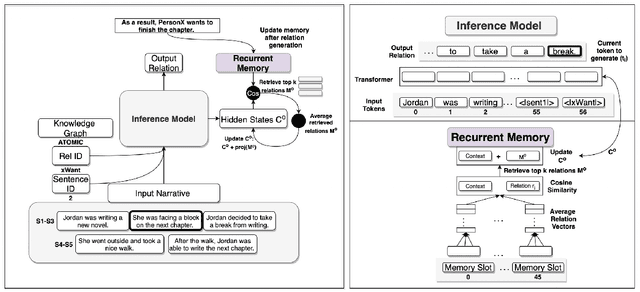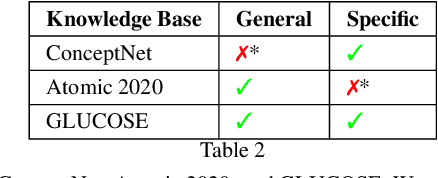Claire Yin
Can Language Models Take A Hint? Prompting for Controllable Contextualized Commonsense Inference
Oct 03, 2024


Abstract:Generating commonsense assertions within a given story context remains a difficult task for modern language models. Previous research has addressed this problem by aligning commonsense inferences with stories and training language generation models accordingly. One of the challenges is determining which topic or entity in the story should be the focus of an inferred assertion. Prior approaches lack the ability to control specific aspects of the generated assertions. In this work, we introduce "hinting," a data augmentation technique that enhances contextualized commonsense inference. "Hinting" employs a prefix prompting strategy using both hard and soft prompts to guide the inference process. To demonstrate its effectiveness, we apply "hinting" to two contextual commonsense inference datasets: ParaCOMET and GLUCOSE, evaluating its impact on both general and context-specific inference. Furthermore, we evaluate "hinting" by incorporating synonyms and antonyms into the hints. Our results show that "hinting" does not compromise the performance of contextual commonsense inference while offering improved controllability.
Adversarial Transformer Language Models for Contextual Commonsense Inference
Feb 10, 2023



Abstract:Contextualized or discourse aware commonsense inference is the task of generating coherent commonsense assertions (i.e., facts) from a given story, and a particular sentence from that story. Some problems with the task are: lack of controllability for topics of the inferred facts; lack of commonsense knowledge during training; and, possibly, hallucinated or false facts. In this work, we utilize a transformer model for this task and develop techniques to address the aforementioned problems in the task. We control the inference by introducing a new technique we call "hinting". Hinting is a kind of language model prompting, that utilizes both hard prompts (specific words) and soft prompts (virtual learnable templates). This serves as a control signal to advise the language model "what to talk about". Next, we establish a methodology for performing joint inference with multiple commonsense knowledge bases. Joint inference of commonsense requires care, because it is imprecise and the level of generality is more flexible. You want to be sure that the results "still make sense" for the context. To this end, we align the textual version of assertions from three knowledge graphs (ConceptNet, ATOMIC2020, and GLUCOSE) with a story and a target sentence. This combination allows us to train a single model to perform joint inference with multiple knowledge graphs. We show experimental results for the three knowledge graphs on joint inference. Our final contribution is exploring a GAN architecture that generates the contextualized commonsense assertions and scores them as to their plausibility through a discriminator. The result is an integrated system for contextual commonsense inference in stories, that can controllably generate plausible commonsense assertions, and takes advantage of joint inference between multiple commonsense knowledge bases.
Data Augmentation for Intent Classification
Jun 12, 2022


Abstract:Training accurate intent classifiers requires labeled data, which can be costly to obtain. Data augmentation methods may ameliorate this issue, but the quality of the generated data varies significantly across techniques. We study the process of systematically producing pseudo-labeled data given a small seed set using a wide variety of data augmentation techniques, including mixing methods together. We find that while certain methods dramatically improve qualitative and quantitative performance, other methods have minimal or even negative impact. We also analyze key considerations when implementing data augmentation methods in production.
 Add to Chrome
Add to Chrome Add to Firefox
Add to Firefox Add to Edge
Add to Edge